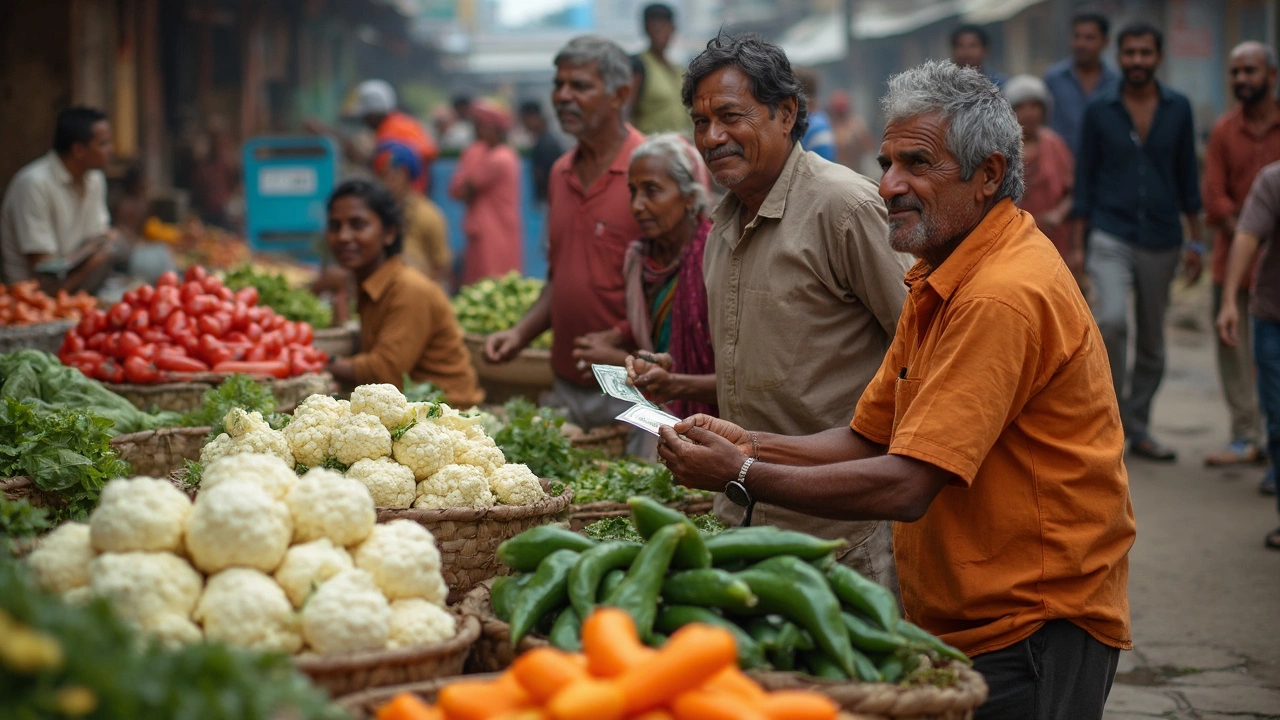If you ask around at any mandi, people always mention the same question—what’s the most profitable vegetable to grow here? There’s no single answer, honestly, but some choices clearly put more money in your pocket than others. In India, a smart pick at the right time can mean a game-changing season for even small farmers.
Before you pick seeds, you need to think about your local market, climate, and even timing. Some veggies like okra (bhindi), bottle gourd (lauki), and tomatoes are favorites because they grow fast and produce over months, giving ongoing harvests. Others, like capsicum (bell peppers) and exotic greens, are grabbing good rates with restaurants and hotels willing to pay more for them.
But here’s the thing—just because a crop is in demand doesn’t mean it’s always profitable. Prices can swing wildly, especially with things like tomatoes and onions. So, it pays to know what’s trending, understand what your local buyers need, and double-check if everyone around you is already flooding the market with the same thing. Nothing hurts more than a bumper harvest that sells dirt cheap because of oversupply.
- What Makes a Vegetable Profitable in India?
- Top Money-Making Vegetables for Indian Farmers
- Market Demand and Price Fluctuations: What to Watch
- Small-Scale vs. Large-Scale Vegetable Farming
- Common Mistakes and How to Avoid Them
- Tips to Maximise Your Profits
What Makes a Vegetable Profitable in India?
It’s not just about growing what you like to eat. When we talk about profitable vegetable farming in India, the real deal is mixing what sells high with what costs less to grow. That means thinking about all the details: input costs, how much you can harvest, the number of pickings, the ease of storing, and—super important—how much people actually want to buy it.
- Yield per acre: Crops like tomato, bhindi, and bitter gourd give 10-15 tonnes per acre. Some hybrid varieties go even higher, cutting your cost per kilo.
- Input costs: Seeds, fertilizers, and pesticides for, say, cabbage and beans aren’t that high compared to exotic stuff like broccoli, which needs more care and special nutrients.
- Market price:** The money you get isn’t steady. Tomatoes, chillies, and onions get crazy prices during off-seasons but sometimes drop near harvest when everyone brings in their crops. Monitoring local rates makes a difference.
- Demand waves: Vegetables that folks use daily—tomato, potato, onion—never go fully out of fashion. Add to that the popularity of greens and salad veggies with younger, health-focused buyers in cities.
- Harvest frequency and shelf life: Bhindi and cucumber need frequent picking but the fresh yield means quicker returns. Onions and potatoes store well, letting you wait for better market prices.
Here’s a quick look at how these factors stack up for some favorites:
| Vegetable | Yield (tonnes/acre) | Input Cost (₹/acre) | Average Market Price (₹/kg) | Shelf Life |
|---|---|---|---|---|
| Tomato | 12-16 | 40,000-60,000 | 10-35 | Short |
| Bhindi | 8-12 | 35,000-50,000 | 15-50 | Short |
| Onion | 10-14 | 30,000-55,000 | 10-45 | Medium |
| Bottle Gourd | 12-18 | 25,000-40,000 | 10-40 | Short |
| Capsicum | 8-10 | 80,000-120,000 | 40-100 | Short |
Notice how high input costs can make even higher-priced crops like capsicum risky unless you’re sure about the market. The idea is to focus on veggies that balance output, cost, and local demand. If you can lock in buyers ahead or tie up with retailers, your chances of success shoot up.
Top Money-Making Vegetables for Indian Farmers
If you’re thinking about profitable vegetable farming in India, some vegetables regularly top the list when it comes to both yield and reliable market rates. Let’s break down the clear winners—plus why they work so well if you’re keen to earn more per acre.
- Tomato: Grows fast, can yield two or even three crops a year, and works in most parts of India. Tomatoes are in constant demand, especially during festive seasons, and even a small patch can bring decent returns if you catch peak prices. Many farmers in Andhra Pradesh and Maharashtra have reportedly made up to ₹2-3 lakh per acre in a good season.
- Green Chilli: A hot pick (literally and financially). Chilli crops produce a steady stream of harvest once they start, and they store and transport well. Andhra, Telangana, and Karnataka lead in production, selling huge volumes to both local and export markets.
- Okra (Bhindi): It’s a beloved staple across India, packed with easy sales at both village haats and city supermarkets. Okra thrives in most soils and offers a long harvesting window, so you’re not stuck waiting all season for a single payday.
- Bottle Gourd (Lauki) and Bitter Gourd (Karela): Both sell well in urban markets and are perfect for warm months. They’re climbers, take up less space, and with proper staking, they give high yields with little fuss.
- Capsicum (Bell Pepper): If you have access to protected farming (polyhouse or greenhouses), capsicum is a goldmine. Farmers supplying to hotels or city retailers report margins up to 40-50%, far above open-field crops.
- Exotic Greens: Spinach (Palak), lettuce, and even broccoli are creeping into the profitable category thanks to rising demand from restaurants and health-aware urban crowds. If your area is near a big city, these can be surprisingly big earners.
Here’s a quick table to compare the average returns of these high-yield vegetables per acre, based on field data from the last two years:
| Vegetable | Potential Income per Acre (INR) | Harvest Cycles per Year |
|---|---|---|
| Tomato | ₹1.5 - 3 lakh | 2-3 |
| Green Chilli | ₹1.2 - 2 lakh | 1-2 |
| Okra | ₹80k - 1.8 lakh | 2 |
| Bottle Gourd | ₹1 - 1.7 lakh | 2 |
| Capsicum (protected) | ₹2 - 5 lakh | 2 |
Don’t forget, price swings hit hardest during oversupply, so talk to local traders and watch what’s trending in your region. Sometimes, growing a less common but much-needed veggie in your area can beat jumping into a crowded market.
Market Demand and Price Fluctuations: What to Watch
Understanding what people actually want to buy—that’s where the profit really starts in profitable vegetable farming India. The most common mistake? Choosing a popular crop just because last year’s prices looked great. The vegetable market swings a lot—take tomatoes, for example. Their prices can drop from ₹60/kg to just ₹4/kg within a few weeks, based on monsoon, transport hiccups, or just too many farmers growing them at the same time.
If you want to stay ahead, you’ve got to track what’s trending in your area. Talk to market agents and shopkeepers regularly. WhatsApp groups are packed with farmers sharing price updates live from mandis. Apps like AgMarknet and Krishify show daily prices for everything from okra to capsicum across Indian markets, so you don’t walk in blind.
Let’s look at an example. Here’s a quick snapshot of average price swings in 2024 for some key veggies according to AgMarknet data. See how much things can change in just three months?
| Vegetable | Highest Price (₹/kg) | Lowest Price (₹/kg) |
|---|---|---|
| Tomato | ₹60 | ₹6 |
| Onion | ₹40 | ₹10 |
| Cauliflower | ₹38 | ₹9 |
| Capsicum | ₹70 | ₹25 |
| Bottle Gourd | ₹32 | ₹12 |
Timing your harvest is everything. If you can hit the market before the flood of crops comes in, you’ll get better rates. Some growers stagger their sowing so they don’t have all their crop ready at once. Others focus on off-season varieties using polyhouse or net house tech. That way, you supply when others can’t, and prices usually spike.
Local festivals and wedding seasons also affect demand. For example, spinach, coriander, and other leafy greens see big demand spikes just before religious festivals. Restaurants and hotels buy a lot of high yield vegetables like bell peppers, zucchini, and lettuce—but they only want clean, unblemished produce, so quality matters as much as timing.
The smartest farmers keep their eyes on three things:
- Local consumption trends (what are nearby towns and cities eating right now?)
- Seasonal oversupply risks—don’t plant your whole field with the same crop as everyone else
- Govt. announcements or weather events—subsidies or bad monsoons shift demand fast
So, don’t just follow the crowd. Keep one foot in the local mandi, the other on your phone screen, and always adjust your plans if you see big swings coming for your Indian vegetable market favorites.

Small-Scale vs. Large-Scale Vegetable Farming
When you’re deciding how big to go with vegetable farming in India, it’s really about what works for your budget, goals, and market. Both small-scale and large-scale setups have die-hard fans, but the profits—and headaches—look pretty different.
On a small farm, you can pay close attention to each plant. Many farmers with 1–2 acres manage to earn good money by growing high-value crops like capsicum, cherry tomatoes, or leafy greens and selling them directly to local markets or restaurants. As one Pune farmer put it,
"With just half an acre, I make what my neighbor earns from his two acres of wheat. The trick? Grow what people want and harvest fresh every other day."Easier pest control, more flexibility for trying trendy or organic veggies, and less risk of huge losses if prices drop—these all work in your favor.
Going large-scale means big yields and the chance to tap wholesale markets or start contracts with supermarkets. You need more workers, more fertilizer, and, let’s face it, deep pockets to handle major pests or bad weather. But the payoff can be huge, especially for vegetables like potatoes, onions, or tomatoes. A 2024 survey found that commercial tomato farms in Andhra Pradesh can pull in up to ₹6 lakh per acre during peak season—but only if the market holds up and there’s no glut.
| Factor | Small-Scale | Large-Scale |
|---|---|---|
| Initial Investment | Lower (₹20,000 - ₹1 lakh/acre) | High (₹1 lakh+/acre) |
| Market Access | Local/Direct | Wholesale/Contracts |
| Profit (per acre) | ₹60,000 - ₹2 lakh | ₹80,000 - ₹6 lakh |
| Risk | Lower (can shift crops easily) | Higher (market swings hurt more) |
If you’re just starting, sticking small has less risk and lets you learn mistakes without losing sleep. Want to build a profitable vegetable farming operation? Start small, get the hang of your market, and scale up once you know what really sells.
The bottom line? Both small and big farms can pull in strong profits, but what works for one person’s land or market might flop elsewhere. No matter the size, listening to your buyers and tracking those price swings gives you the best shot at steady earnings.
Common Mistakes and How to Avoid Them
Everyone dreams of getting rich quick in profitable vegetable farming India, but even the most experienced folks slip up. Avoiding these mistakes really makes the difference between good profits and just breaking even.
One classic error? Growing only what you personally like, not what your customers actually want. A farmer in Maharashtra once said:
“Selling is tougher than growing. If you don’t know who’s going to buy, half your work is wasted.” — Rajeev Kamble, Pune vegetable grower
This just nails it—survey the market before planting loads of one crop, especially if it’s your first time. Don’t skip talking to wholesalers, local shop owners, or even checking prices online.
Another big mistake—overusing fertilizers or pesticides. It might seem like more chemicals mean faster growth, but it actually hurts your soil and can even get your produce rejected by buyers who test for residues. Always follow recommended dosages and give your plants what they actually need.
Many new growers don’t track their costs. Keeping a simple record of money spent on seeds, labor, water, fertilizers, and transport helps you figure out if your farm is truly making profits or if you’re just stuck in a cycle.
Here are some common mistakes farmers make and what you can do instead:
- Ignoring local climate: Just because tomatoes do well in Andhra Pradesh doesn’t mean they’ll thrive in Rajasthan. Pick the vegetable that matches your weather and soil.
- Skipping soil testing: Poor soil ruins profits. Get your soil checked every year and use the right amendments. Local agricultural offices often do this for free or cheap.
- Not preparing for price crashes: Vegetables like tomatoes and onions look super profitable until the market is flooded. Diversify your crops or set up deals with consistent buyers if you can.
- Inconsistent irrigation: Missing even a few days during flowering can cut your yield in half or more. Set up simple drip systems if possible, or buddy up with neighbors for shared watering schedules.
- Poor storage and transport: Losing a big share of your harvest to spoilage is just wasting money. Invest in basic crates and shaded storage to keep veggies fresh until they’re sold.
Look at this actual breakdown based on a survey from Punjab on small-scale Indian vegetable market losses during transport:
| Vegetable | Loss During Transport (%) |
|---|---|
| Tomato | 17 |
| Okra (Bhindi) | 12 |
| Cabbage | 8 |
So even after you’ve grown a healthy crop, small lapses in post-harvest handling eat into your earnings.
The bottom line: talk to buyers early, keep farm records, go easy on chemicals, test your soil, and pay attention to how you store and transport your produce. Avoiding just a couple of these mistakes can really pump up your profits in profitable vegetable farming India.
Tips to Maximise Your Profits
If you want real money from profitable vegetable farming India, it’s all about working smarter, not just harder. Let’s break down what the experienced folks are actually doing on the ground.
- Pick high-yield, quick-growing crops: Okra, cucumber, and spinach can be planted and harvested several times a year. That means more produce from the same patch of land—without waiting ages between harvests.
- Use local and hybrid seeds smartly: Hybrid seeds can give you bigger yields, but they might cost more. Sometimes, local varieties are more resilient and cheaper in the long run—mix it up and see what works best in your soil and climate.
- Manage your costs: Keep tight records. Things like pesticides, fertilizers, and water can sneak up on you. Drip irrigation systems use water way more efficiently, saving you cash on the water bill—plus, many states even offer subsidies now.
- Go organic if possible: Organic veggies usually fetch higher prices, especially in cities. Even switching a part of your land to organic can open up new markets and bulk customers.
- Cut out middlemen: Direct selling—either to nearby hotels, restaurants, or even via WhatsApp groups—can boost your profit per kilo. More and more Indian farmers are making WhatsApp sales work in city suburbs.
- Time your planting and harvesting right: This can make a huge difference. For example, if you can get your tomatoes or onions to market a couple of weeks before the usual flood, prices are much higher.
Thinking in numbers? Check out this simple comparison for three popular high yield vegetables based on input costs and selling price per acre in 2024:
| Vegetable | Avg. Input Cost/Acre (INR) | Avg. Yield/Acre (Quintals) | Avg. Selling Price/Quintal (INR) | Potential Gross Income (INR) |
|---|---|---|---|---|
| Tomato | 32,000 | 220 | 2,000 | 4,40,000 |
| Okra (Bhindi) | 21,000 | 120 | 3,500 | 4,20,000 |
| Bottle Gourd (Lauki) | 14,000 | 95 | 2,800 | 2,66,000 |
One last trick—never stop learning. Join local WhatsApp groups or farmer groups, maybe attend a Krishi Vigyan Kendra training. The best tips often come straight from neighbours who know exactly what works in your area’s soil and climate.





